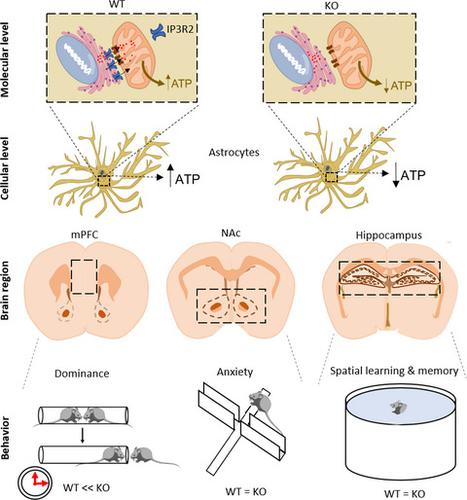当前位置:
X-MOL 学术
›
Eur. J. Neurosci.
›
论文详情
Our official English website, www.x-mol.net, welcomes your
feedback! (Note: you will need to create a separate account there.)
Astrocytic release of ATP through type 2 inositol 1,4,5‐trisphosphate receptor calcium signaling and social dominance behavior in mice
European Journal of Neuroscience ( IF 2.7 ) Pub Date : 2020-07-01 , DOI: 10.1111/ejn.14892 Isabelle Guillot de Suduiraut 1 , Jocelyn Grosse 1 , Eva Ramos-Fernández 1 , Carmen Sandi 1 , Fiona Hollis 2
European Journal of Neuroscience ( IF 2.7 ) Pub Date : 2020-07-01 , DOI: 10.1111/ejn.14892 Isabelle Guillot de Suduiraut 1 , Jocelyn Grosse 1 , Eva Ramos-Fernández 1 , Carmen Sandi 1 , Fiona Hollis 2
Affiliation

|
Brain mitochondrial function is critical for numerous neuronal processes. We recently identified a link between brain energy and social dominance, where higher levels of mitochondrial function resulted in increased social competitive ability. The underlying mechanism of this link, however, remains unclear. Here, we investigated the contribution of astrocytic release of adenosine triphosphate (ATP) through the type 2 inositol 1,4,5‐triphosphate receptor to social dominance behavior. Mice lacking the type 2 inositol 1,4,5‐triphosphate receptor were characterized for their social dominance behavior, as well as their performance on a nonsocial task, the Morris Water Maze. In parallel, we also examined mitochondrial function in the medial prefrontal cortex, nucleus accumbens, and hippocampus to investigate how deficiencies in astrocytic ATP could modulate overall mitochondrial function. While knockout mice showed similar competitive ability compared with their wild‐type littermates, dominant knockout mice exhibited a significant delay in exerting their dominance during the initial encounter. Otherwise, there were no differences in anxiety and exploratory traits, spatial learning and memory, or brain mitochondrial function in either light or dark circadian phases. Our findings point to a marginal role of astrocytic ATP through IP3R2 in social competition, suggesting that, under basal conditions, the neuronal compartment is predominant for social dominance exertion.
中文翻译:

通过2型肌醇1,4,5-三三磷酸受体钙信号的星形胶质细胞释放ATP和小鼠的社会主导行为
脑线粒体功能对于许多神经元过程至关重要。我们最近发现了大脑能量与社会优势之间的联系,其中较高水平的线粒体功能导致社会竞争能力的增强。但是,此链接的基本机制仍不清楚。在这里,我们调查了通过2型肌醇1,4,5-三磷酸腺苷受体星形细胞释放三磷酸腺苷(ATP)对社会主导行为的贡献。缺乏2型肌醇1,4,5-三磷酸受体的小鼠具有社交优势行为和在非社会任务“莫里斯水迷宫”中的表现。同时,我们还检查了内侧前额叶皮层,伏隔核,和海马体研究星形细胞ATP的缺乏如何调节线粒体的整体功能。与野生型同窝仔相比,基因敲除小鼠显示出相似的竞争能力,而优势基因敲除小鼠在初次遭遇时表现出显着的延迟优势。否则,在昼夜节律期或昼夜节律期中,焦虑和探索性状,空间学习和记忆或脑线粒体功能均无差异。我们的研究结果表明通过IP的星形细胞ATP的边际作用 在昼夜节律期和昼夜节律期中,焦虑和探索性状,空间学习和记忆或脑线粒体功能均无差异。我们的研究结果表明通过IP的星形细胞ATP的边际作用 在昼夜节律期和昼夜节律期中,焦虑和探索性状,空间学习和记忆或脑线粒体功能均无差异。我们的研究结果表明通过IP的星形细胞ATP的边际作用3 R2在社会竞争中的作用,表明在基础条件下,神经元区隔是社会支配力发挥作用的主要因素。
更新日期:2020-07-01
中文翻译:

通过2型肌醇1,4,5-三三磷酸受体钙信号的星形胶质细胞释放ATP和小鼠的社会主导行为
脑线粒体功能对于许多神经元过程至关重要。我们最近发现了大脑能量与社会优势之间的联系,其中较高水平的线粒体功能导致社会竞争能力的增强。但是,此链接的基本机制仍不清楚。在这里,我们调查了通过2型肌醇1,4,5-三磷酸腺苷受体星形细胞释放三磷酸腺苷(ATP)对社会主导行为的贡献。缺乏2型肌醇1,4,5-三磷酸受体的小鼠具有社交优势行为和在非社会任务“莫里斯水迷宫”中的表现。同时,我们还检查了内侧前额叶皮层,伏隔核,和海马体研究星形细胞ATP的缺乏如何调节线粒体的整体功能。与野生型同窝仔相比,基因敲除小鼠显示出相似的竞争能力,而优势基因敲除小鼠在初次遭遇时表现出显着的延迟优势。否则,在昼夜节律期或昼夜节律期中,焦虑和探索性状,空间学习和记忆或脑线粒体功能均无差异。我们的研究结果表明通过IP的星形细胞ATP的边际作用 在昼夜节律期和昼夜节律期中,焦虑和探索性状,空间学习和记忆或脑线粒体功能均无差异。我们的研究结果表明通过IP的星形细胞ATP的边际作用 在昼夜节律期和昼夜节律期中,焦虑和探索性状,空间学习和记忆或脑线粒体功能均无差异。我们的研究结果表明通过IP的星形细胞ATP的边际作用3 R2在社会竞争中的作用,表明在基础条件下,神经元区隔是社会支配力发挥作用的主要因素。











































 京公网安备 11010802027423号
京公网安备 11010802027423号